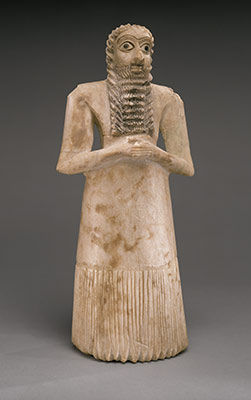Mini-Lecture Art of Ancient Near East
( Mesopotamia )
This area is known as Mesopotamia. It is where the earliest Bible stories of Abraham, Noah; and countless wars between rival groups take place; and may be the setting for the Garden of Eden. It is the core of a region known as the Fertile Crescent located around two great rivers, the Tigress; and Euphrates.
Our recent problems with Iraq demonstrate how this region continues to play a part on the history’s stage, with dictators, and terrorists acting very much like an ancient kings challenging outside enemies.
Each city state had their own protecting King, and Gods which priests communed with in various rituals.
Before the terrorists destroyed the towers, they were destroying large statues of Buddha in Afghanistan. Throughout history various groups wanted to destroy Civilization, and return the ancient ways.
Recent events in Syria, and Iraq are having a negative impact on the history of art.
Islamists have been erasing the history of art by destroying artifacts. In this module we will be looking back in history, and looking forward to a hopeful solution to these dire events.
We will study the beginning of civilization known as the Neolithic Revolution. The two key places where people started to advance beyond the way of life in the Paleolithic, was in Egypt, and Mesopotamia.
Here we see the first farming, and the first cities, along with the art that marks so many other beginnings.
Statues from Tell Asmar

http://www.metmuseum.org/toah/hd/edys/hd_edys.htm
The cylinder form of these figures differ from the block like figures we will find in Egyptian Art. Notice how their eyes are in a trancelike gaze, communing with a supernatural force.
Standing Male Worshipper from Tell Asmar (video) | Khan Academy
The Stele of Hammurabi
http://en.wikipedia.org/wiki/Hammurabi’s_Code
This cylinder describes the codes of law put in place by this Mesopotamian king. Here we see him with the Sun God, Shamish. There is a great deal of realism of the figures in this 7″ high black-asphalt stele.
Dying Lion

Mesopotamia was a very violent place, and it still is.
Groups were constantly fighting over resources such as land and water, or oil. Read the Old Testament if you want a picture of life in this ancient time. There are very few images of compassion towards fellow men. This image of a dying lioness in agony demonstrates a compassionate view towards this poor animal.
The blood is portrayed pouring out of the lion’s wounds. Later in the course, we will see images of Christ that will recall this unique image.
Candela Citations
- Module 2 Egypt and Mesopotamia Mini Lecture Mesopotamian Art. Authored by: J. Bruce Schwabach. Provided by: Herkimer College. Located at: https://herkimer.open.suny.edu/webapps/blackboard/execute/content/blankPage?cmd=view&content_id=_18184_1&course_id=_953_1. Project: Art History I Achieving the Dream Course. License: CC BY: Attribution